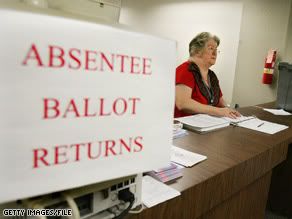This is part of a two-part series evaluating absentee ballots, which are being used more and more often. The first part focused on their advantages. This second part will focus on their disadvantages.
The previous part discussed the two main advantages of absentee ballots: absentee ballots make it easier to vote and enable voters to have more information about obscure ballot measures and races.
Let’s look at the disadvantages. Actually, there’s only one big disadvantage of absentee ballots: the potential for fraud or voter intimidation.
More below.
With in-person voting voter intimidation is quite difficult. Nobody can see how a voter fills in the ballot in the voting booth. Somebody who attempted to see how a voter fills his or her ballot would immediately be arrested. So it’s quite difficult to influence voters with in-person voting.
Not so with absentee ballots. With absentee ballots, the burden of keeping the ballot from prying eyes falls on the voter. The voter is supposed to keep the ballot secret and hidden, rather than the government. People are allowed to “guide” voters or “help” them fill out the ballot. Of course, the guide or helper can pressure a voter to fill out the ballot “correctly.” That’s called voter intimidation.
This is not just hypothetical. It’s happened before. One hears stories of how in the 2008 presidential election Obama’s campaign held “voter parties” where supporters would fill out their absentee ballots together. One shudders to think what would have happened to a supporter who decided to vote Republican in a local race.
There’s also a high potential of fraud. In-person voter fraud requires a person to actually walk up to the voting station and impersonate a voter. Absentee ballot fraud just requires good signature-faking skills. It’s quite easy to catch a person impersonating a voter, but practically impossible to catch a person impersonating a voter’s signature.
That is the great disadvantage of absentee ballots: it’s much easier to do unethical things with them.
–inoljt
